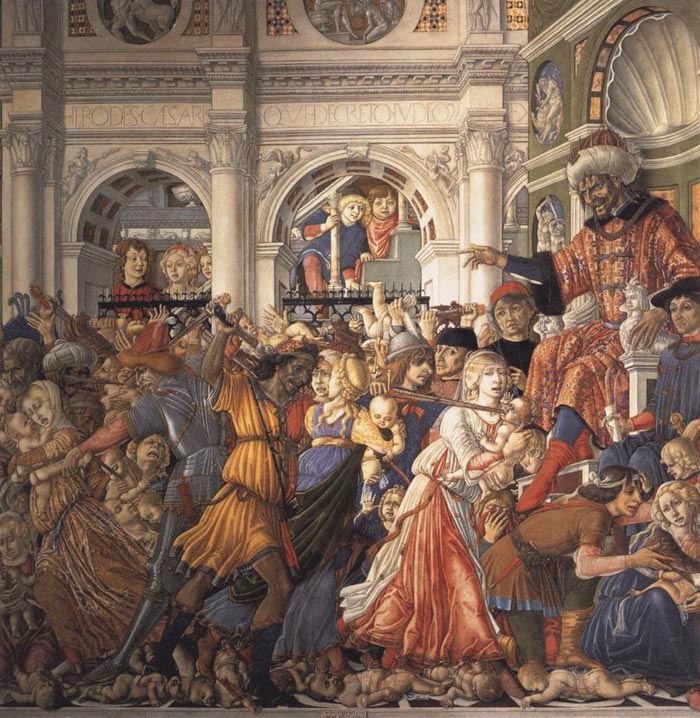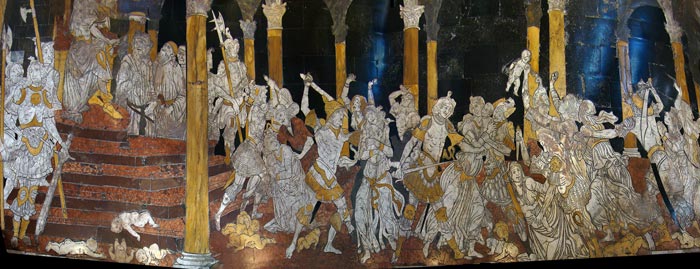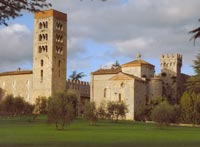Matteo di Giovanni (1435–1495) |
| MATTEO di Giovanni (b. ca. 1430, Borgo San Sepolcro, d. 1495, Siena) Italian (Sienese) painter, who originally came from Borgo San Sepolcro and he painted the wings and predella (Pinacoteca Sansepolcro) of the altarpiece of which Piero della Francesca's Baptism of Christ was the centre panel.
Matteo is first documented in Siena in 1452, when he was commissioned to gild an angel carved in wood by Jacopo della Quercia for Siena Cathedral. In 1457 he decorated the chapel of San Bernardino there. The modest nature of these projects suggests that he was still an apprentice. In this period he collaborated with Giovanni di Pietro, the brother of il Vecchietta, which supports the hypothesis that his early training was in the circle of il Vecchietta. His large surviving oeuvre exemplifies the development of Sienese painting in the 15th century from an emphasis on line and pattern to an early interest in the innovations of contemporary Florentine art. It has been suggested that he was first influenced by Umbrian painting of the mid-15th century, but he was already active in Siena by the early 1450s. This was a decade of transition in the artistic life of the city after the death of Sassetta, Domenico di Bartolo and Pietro di Giovanni d’Ambrogio and before the influx of new ideas during the pontificate of Pius II. His style was elegant, linear, and decorative, revealing affinities with Pollaiuolo, and he seems to have been one of the most popular and prolific Sienese painters of the second half of the 15th century. |
|
| Matteo di Giovanni is best known for four monumental compositions of the Massacre of the Innocents, three for Sienese churches and one in inlaid stone for the pavement of the Duomo. In the version in Sant'Agostino, the arches and columns of Herod's palace suggest that the artist had visited Rome. He has left no foreground space and every inch of Herod's hall is occupied by screaming mothers, dead or dying babies, and bloodthirsty soldiers. The marble pavement is covered by infant corpses. Impassive courtiers flank Herod's throne, while the gloating king is portrayed as a monster: one hand is outstretched to order the butchery; the other, like a claw, clutches the marble sphinx on the arm of his throne. |
|
 |
|
Matteo di Giovanni, Massacre of the Innocents, 1482, The Chapel of our Lady, Ospedale Santa Maria della Scala, Siena
|
|
Matteo di Giovanni, Massacre of the Innocents |
|
| The Chapel of our Lady also holds one of the four versions of the Massacre of the Innocents, which Matteo di Giovanni, an artist born in Sansepolcro, and one of the leading figures of fifteenth-century Sienese art, painted in the course of a decade. The canvas on deposit at Santa Maria della Scala, is the work made by the artist in 1482 for the church of Sant'Agostino in Siena. Matteo di Giovanni painted four monumental compositions of the Massacre of the Innocents, three for Sienese churches and one in inlaid stone for the pavement of the Duomo. The picture painted for Sant'Agostino, like the final one made for the Basilica of Santa Maria dei Servi (also known as San Clement), seems to present some iconographic innovations, probably the fruit of the terrible echo, still resonating among his contemporaries, of the siege and massacre perpetrated by the Turks at Otranto in 1481.
|
|
 |
|
Matteo di Giovanni, Massacre of the Innocents, 1488, Galleria Nazionale di Capodimonte, Naples
|
|
| Siena Duomo | The Mosaic floor |
||
| Sibylla-Samia was the priestess presiding over the Apollonian oracle near Hera's temple on the Isle of Samos, a Greek colony. |
|
 Matteo di Giovanni Bartoli, Sibilla Samia, Floor of the Duomo, Siena |
 |
||
Matteo di Giovanni, Massacre (Slaughter) of the Innocents
|
||
| Matteo di Giovanni Saint Augustine and Saint Michael the Archangel tempera on panel 196x55 cm (frames included) (1474) Asciano - PALAZZO CORBOLI MUSEO D'ARTE SACRA Two side panels of a lost polyptych whose central panel, the Annunciation, is today at the National Gallery in London. Formerly from the Augustinian church of Asciano it was transferred to the church of Santa Eugenia in Monastero, nearby Siena. The paintings represent Matteo di Giovanni’s stylistic period in which he is attracted by the Renaissance’s new ideas of an “eccentric and bizarre” taste. (C.Alessi) The village of Monastero d`Ombrone belongs to the municipality of Castelnuovo Berardenga. |
 |
|
|
||
|
||
| This article incorporates text from the article Matteo di Giovanni,in Wikipedia and the Encyclopædia Britannica, Eleventh Edition, a publication now in the public domain. | ||
|
||

